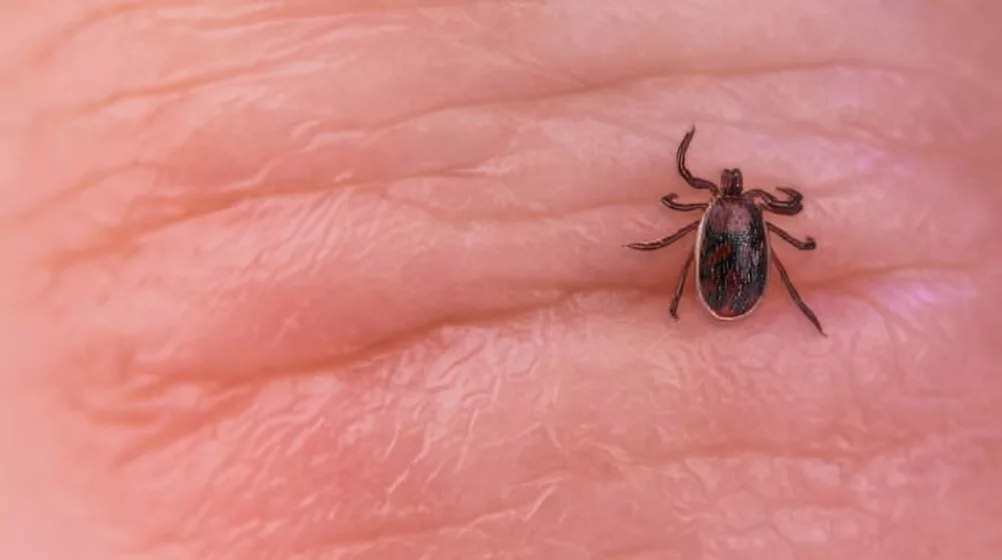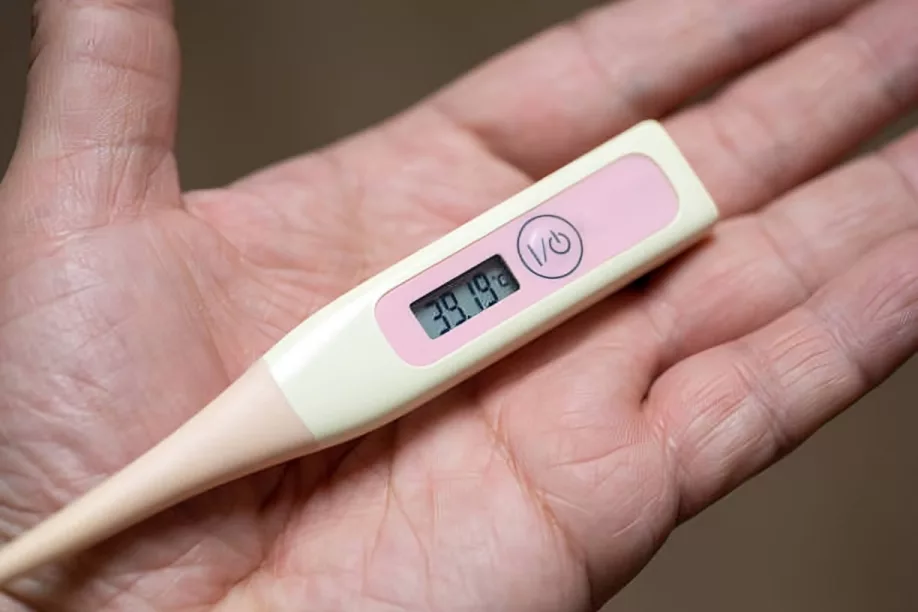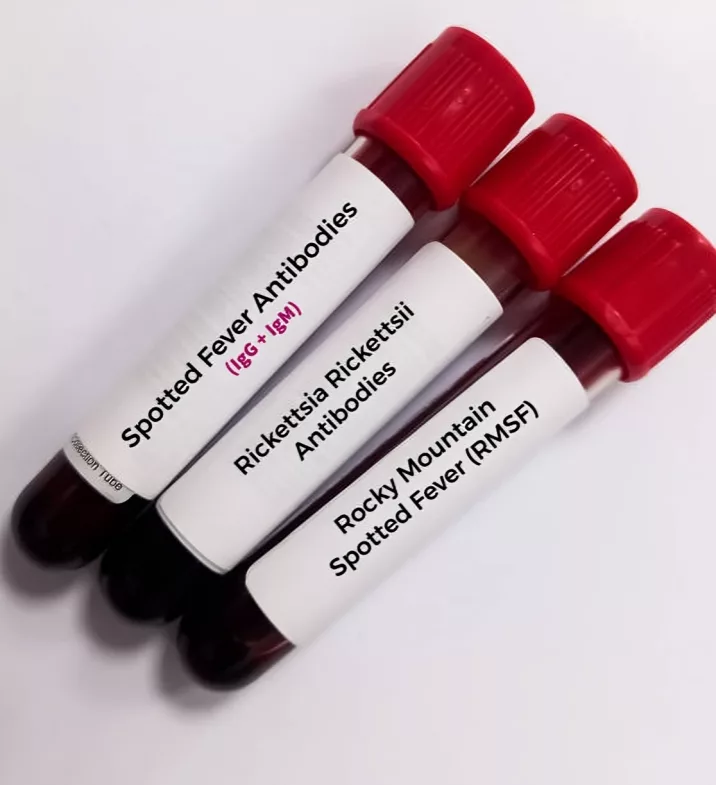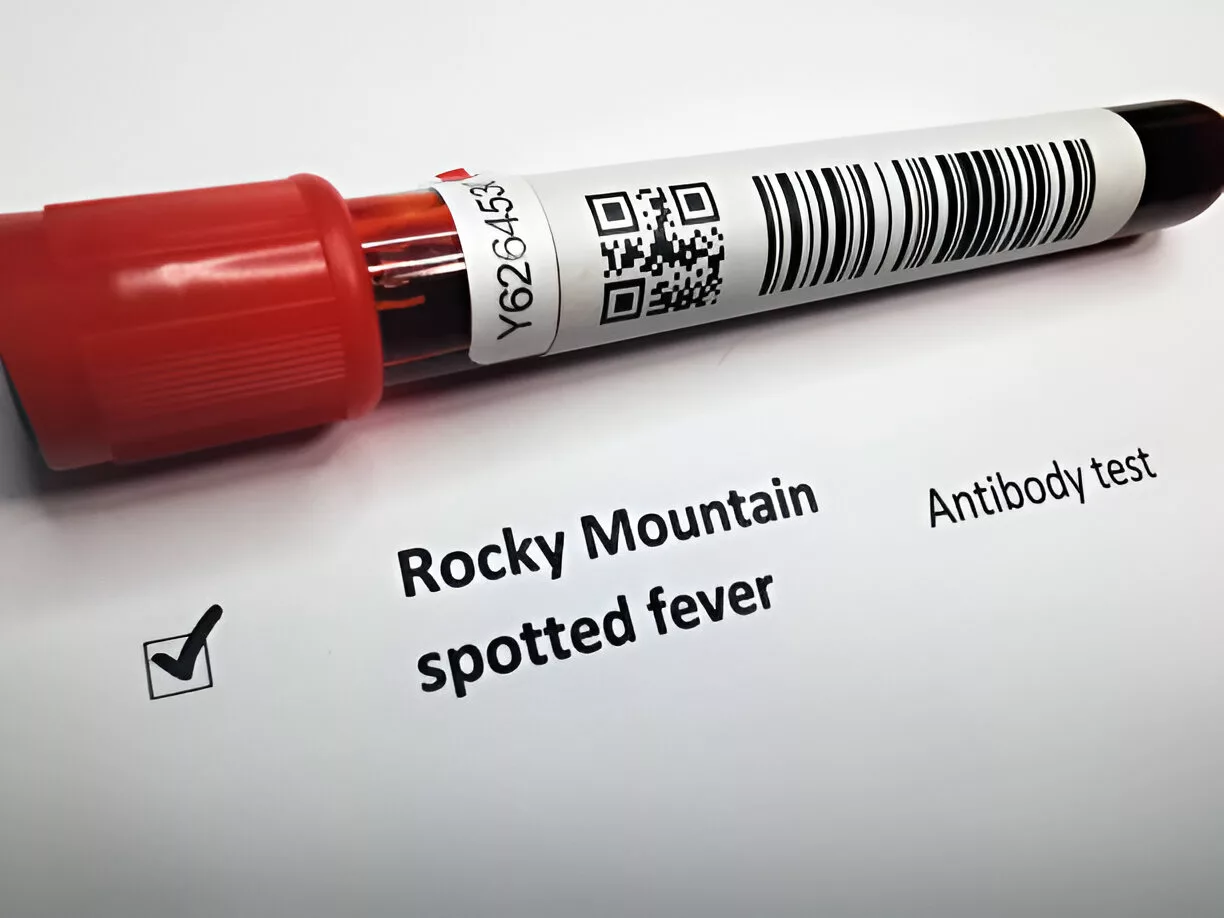Rocky Mountain spotted fever is an infectious illness caused by the bacterium Rickettsia rickettsii and carried by ticks. The disease starts with generalized flu-like symptoms and a characteristic rash. When left untreated, it can progress to multiorgan failure and death.
What is Rocky Mountain Spotted Fever?
Rocky Mountain spotted fever was first recognized by Dr. Howard Ricketts in the Rocky Mountains region of the United States in 1906, hence the name. Now, cases are found beyond the Rockies, all over North and South America. “Spotted fever” refers to the rash of red or purple spots, which are a distinctive sign of the disease.
The culprit behind this potentially deadly infection is Rickettsia rickettsii, a bacteria transmitted through the bite of infected ticks. Once inside your body, the bacteria invade the lining of blood vessels. Blood vessels become inflamed and leaky, and, in severe cases, you may undergo multi-organ failure.1Howard T. Ricketts | Howard T. Ricketts Laboratory (HTRL). (2017). Uchicago.edu. https://htrl.uchicago.edu/about-2-2/howard-t-ricketts/
Causes of Rocky Mountain Spotted Fever
Rocky Mountain spotted fever happens when Rickettsia rickettsii bacteria enter your body through a tick bite. These ticks include the following:
- American dog tick (Dermacentor variabilis)
- Rocky Mountain wood tick (Dermacentor andersoni)
- Brown dog tick (Rhipicephalus sanguineus)
Ticks don’t start off infected — they pick up Rickettsia rickettsii by feeding on an infected host — usually a rodent or small mammal. Once infected, ticks pass the bacteria down to their offspring. Others become infected later in life and spread the bacteria when they bite a new host.
What causes Rocky Mountain Fever Transmission?
A tick carrying Rickettsia rickettsii stays infected for life. Transmission to humans happens when an infected tick latches onto human skin and feeds for several hours. The longer it stays attached, the higher the chance of bacteria entering the bloodstream.
Unlike some other tick-borne diseases, Rickettsia rickettsii isn’t instantly transmitted — it typically takes 6 to 10 hours of feeding. This is why regular tick checks are so important after spending time outdoors. Removing a tick quickly stops the bacteria from spreading.2Rocky Mountain spotted fever: MedlinePlus Medical Encyclopedia. (2020). Medlineplus.gov. https://medlineplus.gov/ency/article/000654.htm

Risk Factors for Rocky Mountain Spotted Fever
A number of factors — mostly environmental — can make you more prone to contracting Rocky Mountain spotted fever. These risk factors include:
Geography
Rocky Mountain spotted fever is prevalent in the southeastern and south-central parts of the United States, especially in states like North Carolina, Tennessee, Arkansas, Oklahoma, and Missouri.
Season
Ticks are more active from late spring to early fall, which is when most Rocky Mountain spotted fever cases occur. However, the brown dog tick, one of the main carriers, can survive indoors and in warmer climates year-round, so the disease is a risk even in cooler months.
Outdoor Activities
Anyone who spends time in grassy fields, wooded trails, or overgrown brush is more likely to get bitten by ticks. Hikers, campers, hunters, and outdoor workers have the highest risk, which multiplies if they don’t take precautions.
Pets
People with dogs or those who work with animals are more likely to be exposed. Dogs can’t get sick from Rocky Mountain spotted, but they can bring infected ticks into homes and yards. The brown dog tick, in particular, infests indoor spaces that the dog comes into contact with.
Age
Children under 10 and adults over 60 are more likely to develop severe RMSF. Kids may not recognize symptoms, and older adults are at greater risk of complications. Delayed treatment in these groups often leads to worse outcomes.
Immunity
A weak immune system makes it harder for your body to fight Rocky Mountain spotted fever. People with diabetes, cancer, HIV, or autoimmune diseases often develop severe symptoms and complications.3Petri, W. A. (2024, January 7). Rocky Mountain Spotted Fever (RMSF). MSD Manual Professional Edition; MSD Manuals. https://www.msdmanuals.com/professional/infectious-diseases/rickettsiae-and-related-organisms/rocky-mountain-spotted-fever-rmsf#Epidemiology_v1009362
Signs & Symptoms
Rocky Mountain spotted fever symptoms usually begin 2 to 14 days after a tick bite. These are often with vague flu-like which make diagnosis difficult, such as:
- High fever
- Severe headache
- Body aches
- Nausea and vomiting
- Loss of appetite
- Fatigue
- General weakness
As the disease progresses, characteristic symptoms of this fever develop, which include:
- Dark spots which spread from extremities to the trunk
- Swelling in hands, feet, or around the eyes
- Confusion
- Neurological changes
- Photosensitivity
- Disturbed vision

Complications of Rocky Mountain Spotted Fever
Rickettsia rickettsii damages blood vessels throughout the body, which affects multiple organs. As a result, this fever can lead to life-threatening complications unless treated early, including:
- Encephalitis
- Pneumonitis
- Myocarditis
- Hypotension and shock
- Gangrene, leading to amputation
- Permanent hearing loss
- Abnormal and uncoordinated body movements
- Multi-organ failure
How is a Rocky Mountain Spotted Fever diagnosis established?
Diagnosing can be challenging because its early symptoms mimic many other illnesses. Since the infection progresses quickly, treatment is often started based on suspicion alone rather than waiting for test results. Diagnosis includes:
History & Physical Exam:
Your doctor will take a detailed history. They will ask about recent outdoor activities, especially in wooded or grassy areas where ticks live. Travel history matters, too, as some regions have more cases. A tick bite raises huge suspicion, especially when accompanied by fever, headache, muscle pain, and rash — along with their timing and progression.
Since early symptoms can be unclear, your doctor won’t wait for all of them to appear. They’ll check for fever — which is almost always there — along with muscle tenderness and other early signs. The rash usually starts as small pink spots on your wrists, ankles, or trunk and may turn dark or purplish as blood vessels get damaged. Severe cases may cause swelling, low blood pressure, confusion, or organ problems.
Lab Investigations:
Several lab tests are conducted to check for organ dysfunction caused by Rickettsia rickettsii, such as:
- Complete blood count
- Liver function tests
- Renal function tests
- Serum electrolytes
- Coagulation profile
However, blood work alone is not enough. Confirmatory tests are necessary to establish a definitive diagnosis, and these include:
- An indirect immunofluorescence assay detects antibodies against Rickettsia rickettsii, but only after the immune system starts responding.
- A polymerase chain reaction or PCR test identifies bacterial DNA in your blood or tissue samples. It can confirm the infection earlier than immunofluorescence.
- A skin biopsy examines a tissue sample from the rash. Using specialized staining techniques, your doctor can detect the bacteria directly through skin biopsies.4Gottlieb, M., Long, B., & Koyfman, A. (2018). The Evaluation and Management of Rocky Mountain Spotted Fever in the Emergency Department: a Review of the Literature. Journal of Emergency Medicine, 55(1), 42–50. https://doi.org/10.1016/j.jemermed.2018.02.043

Treatment of Rocky Mountain Spotted Fever
Treatment should start as soon as the disease is suspected because delays can lead to severe complications.
Doxycycline:
Doxycycline is the main treatment for this fever in both adults and children. It should start as soon as your doctor suspects you have the disease. It is continued for at least 3 days after the fever goes away. The minimum treatment duration is 5 to 7 days. Adults need to take 100mg of doxycycline every hour. Meanwhile, children under 100 pounds need 2.2mg/kg twice a day.
If you are allergic to doxycycline, desensitization in a hospital setting is often chosen as an option. This is because the only alternative to doxycycline is chloramphenicol.
Chloramphenicol:
Chloramphenicol is used in cases where doxycycline is contraindicated. It is often avoided because it is less effective than doxycycline and increases the risk of death. In addition, oral chloramphenicol is unavailable in the United States due to serious side effects, including aplastic anemia and Grey baby syndrome.
Supportive Care:
Supportive care helps your body handle the symptoms. It also prevents complications, even without hospitalization. Supportive measures include:
- IV fluids are used to stabilize your blood pressure and prevent dehydration
- Oxygen therapy may be needed if your lungs are affected.
- Fever and pain are managed with acetaminophen, but your doctor will avoid NSAIDs like ibuprofen to protect your kidney function.
Hospitalization:
Several cases need hospital care. Patients with organ failure, neurological symptoms, or dangerously low blood pressure require close monitoring:
- Ventilators are often needed for lung collapse and respiratory failure
- Dialysis may be required if the kidneys fail
- Round-the-clock care is essential for high-risk patients
- Even after starting treatment, you may develop worsening symptoms. If gangrene develops, emergency surgery might also be needed.5Patel, S. (2024, December 13). Rocky Mountain Spotted Fever (RMSF): Background, Etiology and Pathophysiology, Epidemiology. Medscape.com; Medscape. https://emedicine.medscape.com/article/228042-overview
What is the outcome of Rocky Mountain Spotted Fever?
With modern medicine, most patients recover from Rocky Mountain spotted fever. However, 20-25% of untreated cases are fatal. Most deaths occur between the 7th and 9th day of the illness. Some individuals continue to experience tissue and nerve damage after they are free of the infection.6Fatal Cases of Rocky Mountain Spotted Fever in Family Clusters — Three States, 2003. (2025). Cdc.gov. https://www.cdc.gov/mmwr/preview/mmwrhtml/mm5319a1.htm
Prevention of Rocky Mountain Spotted Fever
The key to preventing this fever is avoiding tick bites and removing ticks as soon as possible. A tick needs to stay attached for several hours before it transmits the infection, which means early removal can prevent infection.
Preventive Measures:
- Stay away from tick-infested areas, especially in spring and summer when ticks. If you’re outdoors, stick to cleared trails and avoid tall grass or brush where ticks hide.
- After coming indoors from the outside, check your entire body for ticks. Pay close attention to hidden areas like behind your ears, underarms, waist, and scalp. Showering within two hours can help wash away any ticks before they attach.
- If you find a tick, immediately get rid of it using fine-tipped tweezers. Grab it as close to your skin as possible and pull straight out without twisting. Avoid crushing the tick since it can release infective fluids. Clean the bite area with antiseptic afterwards.
- Pets can bring ticks inside, so protect yours with vet-approved tick collars, topical treatments, and oral medications. Regular tick checks on your pets can also help prevent infestations in your home.
- Keep your yard tick-free by mowing the grass short and removing leaf piles. Place gravel or chips of wood between your lawn and other wooded areas. This makes it harder for ticks to move into your space.
- You can wear long sleeves, pants, and closed-toe shoes to keep ticks off of your body. Wearing light-colored clothes also makes it easier to spot ticks before they attach to your skin.
- In order to repel ticks, you can use insect repellents with 20-30% DEET (N, N-diethyl-meta-toluamide) on your skin and permethrin on your clothing. Permethrin-treated clothes protect you even after several washes.7Repellent-Treated Clothing | US EPA. (2013, July 15). US EPA. https://www.epa.gov/insect-repellents/repellent-treated-clothing
Is Rocky Mountain Spotted Fever Contagious?
The only way to contract this fever is through the bite of an infected tick. There is no evidence that RMSF spreads through saliva, sexual contact, or blood transfusions.
However, in rare cases, Rickettsia rickettsii has been found in blood, which means handling infected blood or tissues—such as in medical or lab settings—could pose a risk if proper precautions aren’t taken.
What can be mistaken for Rocky Mountain Spotted Fever?
Rocky Moutain spotted fever often starts with generalized symptoms, which makes a diagnosis difficult since it has many similarities with other diseases. Some of the differential diagnoses for this fever are:8Snowden, J., & Simonsen, K. A. (2023, July 17). Rocky Mountain Spotted Fever (Rickettsia rickettsii). Nih.gov; StatPearls Publishing. https://www.ncbi.nlm.nih.gov/books/NBK430881/
| Disease | Similarities to Rocky Mountain spotted fever | Differences from Rocky Mountain spotted fever |
| Influenza | Fever, Headache, Muscle aches, Fatigue | No rash, No history of tick bites, Respiratory symptoms are more common |
| Bacterial meningitis | Fever, Headache, Neck stiffness, sometimes a rash | The rash is not petechia; Neck stiffness is more common |
| Viral meningitis | Uncommon rash, No dark rash, Milder symptoms | Usually milder, No tick bites, no rash |
| Ehrlichiosis | Usually milder, No tick bites rash | Uncommon rash, No dark rash Milder symptoms |
| Anaplasmosis | Tick-borne Flu-like symptoms, low platelet count | No rash, Different geography |
| Lyme disease | Fever, Fatigue, Rash, History of tick bite | Characteristic “bullseye” rash, Different geography, More serious complications |
Rocky Mountain Spotted Fever vs Lyme Disease
Rocky Mountain spotted fever and Lyme disease are both tick-borne illnesses. Different bacteria cause them — Rocky Moutain spotted fever is caused by Rickettsia rickettsii, whereas Borrelia burgdorferiI causes Lyme disease. Though both have generalized symptoms and a rash, Lyme disease is characterized by erythema migrans — a bullseye-shaped rash at the site of the tick bite. In addition, Lyme disease can lead to more chronic complications such as arthritis, neurological deficits, and cardiovascular problems.
Conclusion
Rocky Mountain spotted fever is a bacterial infection transmitted by ticks. It starts with flu-like symptoms and causes a distinctive rash with dark spots. If left untreated, it can cause serious complications, such as multi-organ failure. The mainstay for treatment is doxycycline and supportive care.
Refrences
- 1Howard T. Ricketts | Howard T. Ricketts Laboratory (HTRL). (2017). Uchicago.edu. https://htrl.uchicago.edu/about-2-2/howard-t-ricketts/
- 2Rocky Mountain spotted fever: MedlinePlus Medical Encyclopedia. (2020). Medlineplus.gov. https://medlineplus.gov/ency/article/000654.htm
- 3Petri, W. A. (2024, January 7). Rocky Mountain Spotted Fever (RMSF). MSD Manual Professional Edition; MSD Manuals. https://www.msdmanuals.com/professional/infectious-diseases/rickettsiae-and-related-organisms/rocky-mountain-spotted-fever-rmsf#Epidemiology_v1009362
- 4Gottlieb, M., Long, B., & Koyfman, A. (2018). The Evaluation and Management of Rocky Mountain Spotted Fever in the Emergency Department: a Review of the Literature. Journal of Emergency Medicine, 55(1), 42–50. https://doi.org/10.1016/j.jemermed.2018.02.043
- 5Patel, S. (2024, December 13). Rocky Mountain Spotted Fever (RMSF): Background, Etiology and Pathophysiology, Epidemiology. Medscape.com; Medscape. https://emedicine.medscape.com/article/228042-overview
- 6Fatal Cases of Rocky Mountain Spotted Fever in Family Clusters — Three States, 2003. (2025). Cdc.gov. https://www.cdc.gov/mmwr/preview/mmwrhtml/mm5319a1.htm
- 7Repellent-Treated Clothing | US EPA. (2013, July 15). US EPA. https://www.epa.gov/insect-repellents/repellent-treated-clothing
- 8Snowden, J., & Simonsen, K. A. (2023, July 17). Rocky Mountain Spotted Fever (Rickettsia rickettsii). Nih.gov; StatPearls Publishing. https://www.ncbi.nlm.nih.gov/books/NBK430881/





